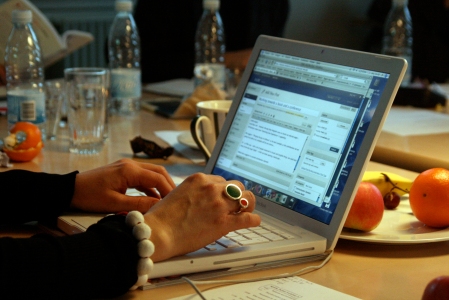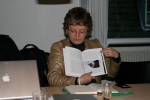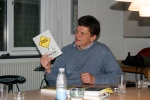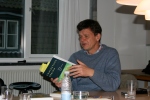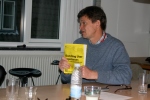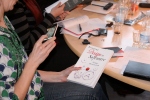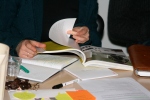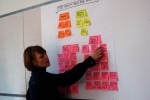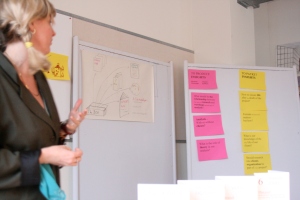Joachim Halse opened the discussion on tools with a presentation asking what are tools for and what are good tools Tools for the toolbox presentation
Question of resources and time
Engaging participants – how complete can you make the tools so that they are still engaging?
Using tools always takes time even though you would be used to use it – to get in the right mood. Each game is different just because the participants and the context keeps changing.
Can we use the methods cards as a way to discuss with clients the options for what we can do together? One perspective on tools could be to communicate what I’m good at.
Can we say that Daim tools are meant to be used when you want to improve something? The narrative part was in all of the examples… everyone can produce narratives (the background doesn’t matter) so could that be somehow a characteristic of a Daim tool?
Katja talking about the possible audiences for the tools – a scientific or a compagny context
Who is the audience of the tool-box and the book; are we the audience since we include already various people? The idea of something like Ideo cards is partly to be “cool” and it works for Ideo but what is the idea in the Daim tools? How do we all think to use the tools? That would be important to think about and discuss?
How do you make your tools your own? Is it used in a scientific context? In a company context or in a mixture? We have to be more specific with these issues. Is the tool general or very spesific? Open for various applications by different people. sharing tools is not problematic, but being more specific for the audience and who will use it. Tools can be used for selling our skills…
Different tools for different purposes? You need to change the tools according to the customer, you don’t want to use the same tools every time with the same customer. It could be interesting if tools can be used by the help of a manual, open at some level such as the dice example in which you can change the context but still use the same basic idea. Tools with the possiblty of modifying and improving – the manual is needed for general instructions.
Ellen explaining her model that looks like a web
Pictures with previous examples which show that people really will use a huge dice if you make them to do it. Are snapshots part of the tools? One thing is tools another is inspiration. To give inspiration is a bit more open than a tool which is more concrete. Inspirational ways of working through examples of how things could be done – emphasizing inspiration rather than tangible tools.
Inspiration and learning is important but tools should be able to be adapted by design agencies. Are we really doing antropological design innovations or just inspired from those ideas? Is the tool going to be usable for design agencies, that would be fantastic but is it the most fruitful way to go on?
Have design agencies used similar tools as introduced by Joachim? Yes, but one of the big chalenges is how to use the material from those in an efficient way? Do you need many years of training. Ideo cards can be used for inspiration and in different ways based on the people using the cards. Design games have been partly succesful but sometimes those just take too much time, then there is a need to develop the tool (design game) to be more effective.
Is the tools just for opening things up? helping to get started?
Does tools create insights which we can act upon, or engagement?
Appreciation of doing it by yourself, design principles and rules for the tools help to apply tools, guidelines for what the tool is good for. When are we using the tools? For making a new team? What is the connection between the model and the tools? Or are those totally unconnected? There are many stages in the process and thus the model and tools could be somehow showing those. Characterising tools based on the different stages they are designed for? At the same time explaining the model and the tools. To sell projects and tools for customers, to communicate to new workers how things are done in the agency. Flow market at the Danish Design Centre is an example of making abstract things like “happiness” concrete by putting it as a label for the can etc.
Maybe instead of thinking what is a Daim tool we should be discussing what it is not? Like personas are probably not a Daim tool.
The idea of today’s discussion is mainly to open up the discussion not map all the practices and examples but work as opening for the theme. Use the insights from the pilot project, not to start from scratch. Ethnographic fieldwork, games, workshops are used already widely so what is the contribution of these new tools? The workshop as a label is too wide. More specific descriptions of the methods would be usable for agencies. Because of busy timetables in the agencies they tend to use the same methods but they would like to get a chance to emphasise other methods (also the ones they already had tried but don’t use regularly or don’t master them yet).
Daim tool-box: audience, improvement, learning, narratives, grounding. when selling a project the tool box can be used for communicating the possible process based on the starting point “if you want to get this perspective then you have to include this and this perspective in the project”.
Map the challenges involved, what challenges I face when organising workshops. E.g. how can I as a researcher learn from the workshops (typically clients learn during workshops more than the researcher)
Tool box should be suitable for the beginners, as well not just for the design agencies.
